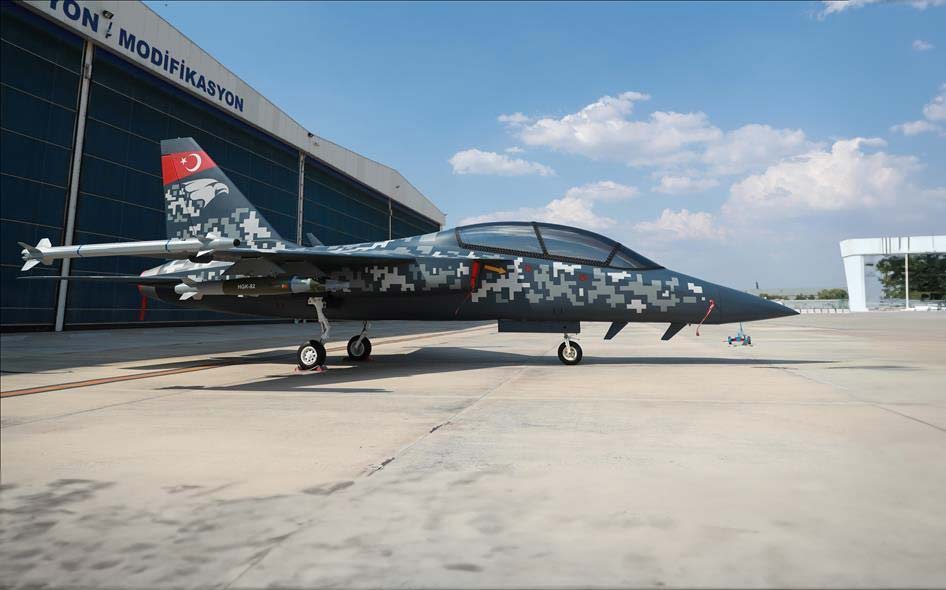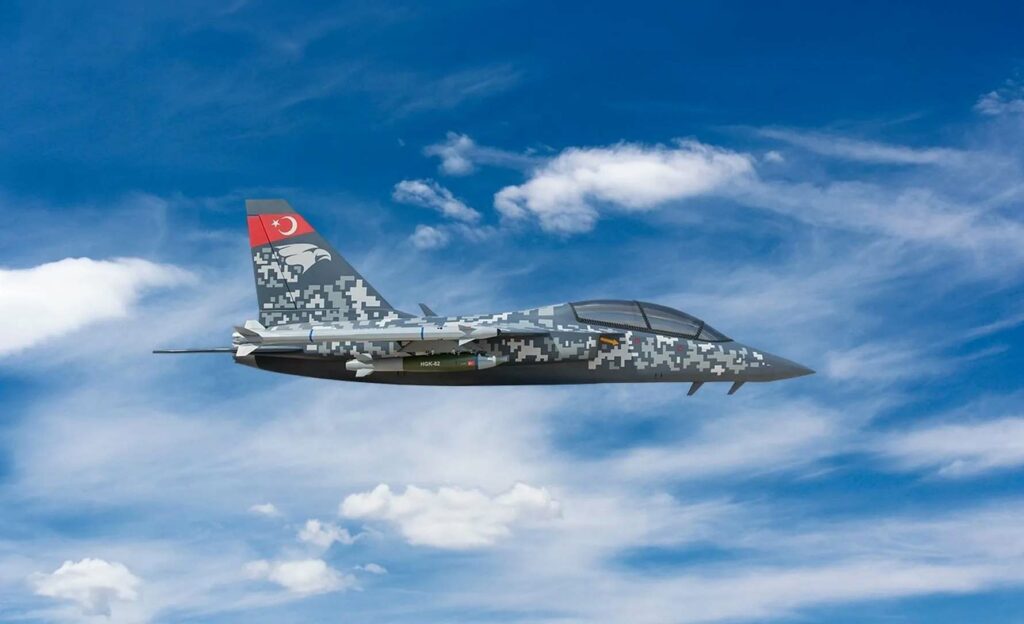The TAI Hürjet is a Turkish single-engine, tandem-seat, supersonic advanced jet trainer and light combat aircraft, designed to replace aging trainer fleets and enhance pilot training capabilities.
The TAI Hürjet is a single-engine, tandem-seat, supersonic advanced jet trainer and light combat aircraft developed by Turkish Aerospace Industries (TAI). Designed to replace the Turkish Air Force’s aging T-38 Talon trainers and F-5 aircraft used by the Turkish Stars aerobatic team, the Hürjet features a modern avionics suite, fly-by-wire controls, and a glass cockpit. The aircraft measures approximately 13.4 meters (44 feet) in length, with a wingspan of 11 meters (36 feet). Powered by a General Electric F404-GE-102 turbofan engine, it is capable of reaching speeds up to Mach 1.4, with a service ceiling of 45,000 feet (13,716 meters) and a range of 2,222 kilometers (1,380 miles). The Hürjet is equipped with seven external hardpoints, allowing it to carry a variety of air-to-air and air-to-ground munitions, making it suitable for both training and light combat roles.
History of Development
In the mid-2010s, the Turkish Air Force identified the need to replace its aging fleet of T-38 Talon trainers and F-5 aircraft used by the Turkish Stars aerobatic team. These platforms, having served for decades, were becoming increasingly challenging to maintain and lacked the advanced systems present in modern fighter jets. Recognizing the necessity for a contemporary training solution that could prepare pilots for next-generation aircraft, Turkish Aerospace Industries (TAI) initiated the Hürjet project in August 2017 as a privately funded venture.
The primary objective was to develop a supersonic, single-engine, tandem-seat jet trainer that could also perform light combat and close air support missions. The project gained official backing from the Turkish Undersecretariat for Defence Industries (SSB) in July 2018, solidifying its status and providing the necessary support for further development.
TAI unveiled a full-scale mock-up of the Hürjet at the Farnborough International Airshow in July 2018, showcasing the design to the global aerospace community. The mock-up highlighted the aircraft’s sleek design and modern avionics, generating interest from potential international partners and customers.
Throughout 2019 and 2020, TAI focused on finalizing the aircraft’s design and selecting appropriate systems and components. A significant milestone was achieved in February 2021 when the Critical Design Review (CDR) was completed, allowing the project to transition into the prototype manufacturing phase.
The first prototype’s assembly commenced in June 2021, with TAI aiming for an aggressive development timeline. On April 25, 2023, the Hürjet prototype conducted its maiden flight from TAI’s facilities in Ankara. The aircraft reached an altitude of 14,000 feet and a speed of 250 knots during a 26-minute flight, marking a pivotal moment in Turkey’s aviation history.
Following the successful first flight, the Hürjet underwent a series of test flights to evaluate its performance and systems. Notably, on September 3, 2023, the prototype performed a formation flight with the Turkish Stars aerobatic team, demonstrating its potential role as a replacement for the aging F-5 aircraft.
In July 2024, TAI, GE Aerospace, and TEI signed a Memorandum of Understanding to integrate the General Electric F404 engine into new Hürjet variants and establish assembly, inspection, and testing capabilities in Turkey. This agreement aimed to enhance the aircraft’s performance and support potential export opportunities.
The Hürjet’s development reflects Turkey’s broader ambitions to strengthen its domestic defense industry and reduce reliance on foreign suppliers. By creating an indigenous advanced jet trainer and light combat aircraft, Turkey aims to meet its own military needs and position itself as a competitive player in the global defense market.

Design of the TAI Hürjet
The TAI Hürjet features a sleek, aerodynamic design optimized for both training and light combat roles. The aircraft measures approximately 13.4 meters (44 feet) in length, with a wingspan of 11 meters (36 feet) and a height of 4.1 meters (13.5 feet). The airframe incorporates advanced composite materials to reduce weight and enhance structural integrity, resulting in an empty weight of around 4,500 kilograms (9,920 pounds) and a maximum takeoff weight of 9,800 kilograms (21,605 pounds).
The tandem-seat configuration allows for an instructor and trainee pilot, with both positions equipped with Martin-Baker Mk T-16 N zero-zero ejection seats, ensuring crew safety during emergency situations. The cockpit is designed with a modern glass layout, featuring a wide-area display (WAD), head-up display (HUD), and an integrated helmet-mounted display system (HMDS). These systems provide pilots with critical flight information, enhancing situational awareness and reducing workload.
The Hürjet employs a digital fly-by-wire (FBW) flight control system with parameter limiting, enhancing handling characteristics and flight safety. This system replaces traditional mechanical linkages with electronic signals, allowing for more precise control inputs and automated stability augmentation.
The aircraft’s wing design incorporates a leading-edge sweep angle of approximately 30 degrees, optimizing it for supersonic flight while maintaining good low-speed handling qualities. The wings house integral fuel tanks, increasing the aircraft’s fuel capacity without compromising aerodynamic efficiency.
Performance of the TAI Hürjet
The TAI Hürjet is powered by a General Electric F404-GE-102 turbofan engine, providing 17,700 pounds (78.7 kN) of thrust. This engine, also used in aircraft like the F/A-18 Hornet and Saab JAS 39 Gripen, offers a balance between power, efficiency, and reliability. The Hürjet is a supersonic aircraft, reaching a maximum speed of Mach 1.4 (1,728 km/h or 1,074 mph), making it one of the fastest trainer aircraft currently in development.
The aircraft has a service ceiling of 45,000 feet (13,716 meters), allowing it to operate in high-altitude training and interception missions. Its maximum range is approximately 2,222 kilometers (1,380 miles), but this can be extended using external fuel tanks, increasing its operational endurance.
The Hürjet’s rate of climb is estimated at 35,000 feet per minute (178 m/s), which is comparable to other advanced jet trainers like the Boeing T-7 Red Hawk and the KAI T-50 Golden Eagle. Its thrust-to-weight ratio is approximately 0.91, providing excellent acceleration and maneuverability in both training and combat scenarios.
The aircraft is designed with a 30-degree swept wing, optimizing it for supersonic flight. The wings house integral fuel tanks, extending the aircraft’s endurance while maintaining aerodynamic efficiency. The fly-by-wire flight control system ensures precision in handling, making it well-suited for pilot training before transitioning to next-generation fighters like the Lockheed Martin F-35 or Eurofighter Typhoon.
Compared to its competitors, the Hürjet provides a modern alternative to older trainers like the T-38 Talon. It is slightly faster than the KAI T-50 Golden Eagle, which has a maximum speed of Mach 1.2, but it remains within a similar performance category. The Boeing T-7 Red Hawk, which the U.S. Air Force selected for its next-generation trainer, has similar capabilities but features a different avionics package and training environment integration.
The Hürjet’s takeoff distance is approximately 1,200 meters (3,937 feet), and it can land within a similar distance depending on weight and loadout. This capability allows it to operate from shorter runways, making it flexible for both training and combat scenarios.
With its advanced digital cockpit, superior maneuverability, and high thrust-to-weight ratio, the Hürjet is positioned as a modern trainer and light combat aircraft. It is capable of performing aggressive combat maneuvers, including high-G turns and supersonic intercepts, making it an ideal training platform for fourth- and fifth-generation fighter pilots.
Variants of the TAI Hürjet
1. Hürjet AJT (Advanced Jet Trainer)
The baseline version of the Hürjet is the Advanced Jet Trainer (AJT), designed to replace aging trainer aircraft in the Turkish Air Force. This variant is optimized for pilot transition training, aerobatics, and tactical training before pilots move on to advanced multirole fighters like the F-16 or F-35.
2. Hürjet LCA (Light Combat Aircraft)
The Light Combat Aircraft (LCA) variant is equipped with seven external hardpoints, allowing it to carry air-to-air and air-to-ground munitions. It features an advanced fire control radar, electronic warfare capabilities, and a targeting pod for precision-guided munitions. This version is intended for air policing, close air support (CAS), and light strike missions.
3. Hürjet Carrier-Based Variant
A navalized version of the Hürjet is under development for Turkey’s future aircraft carrier, TCG Anadolu. This version includes reinforced landing gear, an arrestor hook for short takeoff and landing, and modifications to operate from shortened runways or carrier decks.

Military Use and Combat of the TAI Hürjet
The TAI Hürjet is designed as a versatile platform for both advanced pilot training and combat missions. The Hürjet LCA variant is configured to carry a variety of weapon systems on its seven external hardpoints, including:
- Air-to-air missiles: AIM-9X Sidewinder, AIM-120 AMRAAM, and Turkey’s indigenous Gökdoğan and Bozdoğan missiles.
- Air-to-ground munitions: Laser-guided bombs (LGBs), JDAMs, and precision-guided munitions.
- Unguided and guided rockets: 70mm rockets, including CIRIT laser-guided rockets.
- Guns: External gun pods equipped with 20mm or 30mm cannons.
- Electronic warfare pods and targeting pods for SEAD (Suppression of Enemy Air Defenses) missions.
Operational Use
As of 2024, the Hürjet has not yet seen combat, as it remains in final testing and production phases. However, it is expected to enter full operational service in 2025. The Turkish Air Force plans to use it primarily as a lead-in fighter trainer (LIFT) to prepare pilots for advanced aircraft like the F-16V and the TF-X Kaan.
Potential Export Markets
Turkey has actively marketed the Hürjet to countries seeking an affordable supersonic trainer and light combat aircraft. Nations with aging fleets of T-38, F-5, and MiG-21 aircraft are considered potential buyers.
- Malaysia: The Royal Malaysian Air Force (RMAF) is a potential customer, as Malaysia is looking to replace its Hawk 108/208 trainers.
- Bangladesh and Pakistan: Both countries have expressed interest in acquiring a cost-effective trainer and light combat aircraft.
- Azerbaijan: A strong defense relationship with Turkey makes Azerbaijan a potential first export customer.
Comparison to Competitors
The Hürjet competes with other supersonic trainers and light combat aircraft, including:
- Boeing T-7 Red Hawk
- KAI T-50 Golden Eagle
- Leonardo M-346 Master
- HAL Tejas (Trainer variant)
The Boeing T-7 Red Hawk was selected by the U.S. Air Force as its next advanced jet trainer, but it lacks a light combat variant. The KAI T-50 Golden Eagle, currently used by South Korea, Indonesia, and the Philippines, offers similar supersonic performance but does not include as many indigenous components as the Hürjet.
Future Upgrades
The Hürjet’s modular design allows for upgrades, including:
- A future AESA radar integration
- Electronic warfare enhancements
- Indigenous Turkish missile integration
The TAI Hürjet represents a significant advancement in Turkey’s aviation industry, offering a modern supersonic jet trainer and light combat platform. It combines a powerful General Electric F404 engine, a digital glass cockpit, and an advanced fly-by-wire system to provide optimal performance for both training and combat roles.
With a top speed of Mach 1.4, a 45,000-foot ceiling, and seven external hardpoints, the Hürjet is well-suited for lead-in fighter training (LIFT), air policing, and close air support (CAS) missions. The Hürjet LCA variant enhances its combat potential, making it a flexible multi-role aircraft.
The Turkish Air Force has committed to the Hürjet as a replacement for its aging T-38 Talons. It has also gained international interest, with potential buyers in Malaysia, Pakistan, and Azerbaijan.
With ongoing avionics upgrades, improved radar systems, and expanded export opportunities, the Hürjet is positioned as a competitive alternative to the Boeing T-7 and KAI T-50, offering an affordable and high-performance supersonic trainer and light attack aircraft.
The aircraft is expected to enter full operational service by 2025, strengthening Turkey’s aerospace capabilities and securing its place in the global defense market.
Back to the Trainers section.